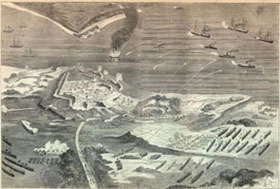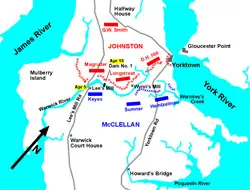


| |||||||||||||||||||||
|
Maj. Gen. George B. McClellan landed his 105,000-man army at Fort Monroe in March where an armada of almost 400 vessels had delivered his army, intending to conquer the Virginia peninsula immediately. In his path were only 10,000 Confederates, commanded by Maj. Gen. John B. Magruder, occupying a line across the tip of the peninsula between Yorktown and the Warwick River. Magruder moved his men from one point to another to create the impression of a troop strength greater than he had. To enhance the bluff, he even placed "Quaker Guns", logs painted black to resemble cannon. Magruder’s theatrics convinced the Federals that his works were strongly held. Yet Magruder was less than confident.
On the other side of the line, McClellan was impressed by Magruder's position. Confederate batteries at Gloucester Point on the York River hindered Union naval operations and prevented McClellan from transporting troops upriver beyond Yorktown. The Confederate ironclad, C.S.S. Virginia, sealed the James River. Probing the Yorktown line, McClellan's forces were surprised to find the Warwick River a significant stream. Units that struck Magruder's defenses nearer Yorktown later reported their strength.
McClellan therefore decided to suspended the march up the peninsula toward Richmond undertake seige operations, bring up heavy artillery, and blast the Confederates uot of their works. His course was cautious because he believed Magruder's bluff. He thought that the Confederates had at least 100,000 men, possibly more. His caution was also due to his pique at being denied use of Maj. Gen. Irvin McDowell's oversized corps to support his operations. After making a reconnaissance of the Confederate line and with intelligence reports projecting Confederate forces as large as his own, McClellan decided to lay siege to Yorktown. Brig. Gen. Fitz-John Porter was placed in charge of siege operations and work on Union fortifications began. Meanwhile, Magruder, and later Gen. Joseph E. Johnston, kept improving the Confederate defenses.
 Click To Enlarge |
Rainy weather favored the Confederates. Magruder's dams turned small streams into major barriers. However, the Union army made advances and prepared more positions. Minor forays gave new soldiers combat experience and broke the monotony of the siege.
On April 16, a serious threat arrived when a Union assault tried to force the Confederates to halt work on their defenses at Dam No. 1 near Lee's Mill, several miles from Yorktown.
At one point, in a balloon operated by Professor Thaddeus Lowe, Porter made an observation flight over Confederate lines. When the mooring broke, the balloon drifted over the Confederate lines. Before the they could fire on Porter, a changing wind carried him back to the Union lines. Despite this problem, Professor Lowe continued his observation flights. This was an early step in the development of aerial reconnaissance.
Despite harassing fire, McClellan's troops slowly advanced their siege works and artillery. The Union arsenal of 101 siege guns included Parrott guns ranging from 20lb. to 200lb. There were over 40 siege mortars, the largest being the 13-inch seacoast mortar which weighed almost 9 tons and fired a 220lb. shell. Never before had so much artillery been massed in one place in the history of the world.
While Union field batteries fired continuously during the siege, only 1 siege battery fired on the Confederates. McClellan planned to open his artillery barrage on May 5, concentrating his efforts at Yorktown and along a portion of the Confederate line just outside Yorktown. The plan also called for Union gunboats to give supporting fire from the York River.
McClellan, to the irritation of some, always insisted on thoroughness in planning and preparation, and the Peninsula Campaign was no exception. he overestimated the Confederate's strength and suddenly Johnston, in the face of superior numbers and firepower, forfeited the ground as untenable.
The seige lasted throughout April. During that time, the Confederates assured themselves that McClellan was the primary threat to Richmond and reinforced Magruder with Johnston's army.
On April 16, Union forces probed a weakness in the Confederate line at Lee’s Mill/ Dam No. 1, resulting in about 309 casualties. Failure to exploit the initial success of this attack, however, held up McClellan for 2 additional weeks, while he tried to convince his navy to maneuver the Confederates’ big guns at Yorktown and Gloucester Point and ascend the York River to West Point thus outflanking the Warwick Line.
McClellan planned for a massive bombardment to begin at dawn on May 4th, 3 days before his intended approach to Yorktown.
On May 3, during the night , the Confederate army slipped away in the night toward Williamsburg. As early as April 30, Johnston had planned to withdraw. Around midnight of May 3, the Confederate heavy guns had ceased their diverting fire, were spiked and left behind by the retreating army.
On May 4, at dawn, the Union army discovered Yorktown abandoned. However, the Confederates had left behind land mines, which claimed the lives of several Union soldiers. The Confederates were seeking more favorable circumstances in which to confront the Federals. The Federals surged forward in pursuit, and the seige of Yorktown ended. The Confederate withdrawal was well planned and executed. A mile east of Williamsburg, Magruder had built another fortified line. Johnston elected to delay the Union pursuit here. During the afternoon, the Battle of Williamsburg began, lasting into the next day.
On May 6, Johnston resumed his march towards Richmond. By delaying the Union army for almost a month, the Confederates had obtained valuable time to assemble and organize the forces that eventually beat McClellan back from the gates of Richmond and thwarted the Union's Peninsula Campaign.
On August 26th, McClellan and most of the Army of the Potomac left the Peninsula. Some regiments were left behind at Yorktown. Yorktown remained in Union control for the rest of the war and was maintained as a military garrison until the summer of 1864.
In 1863, forces from Yorktown participated in what is known as the Second Peninsula Campaign against Richmond. The following year, almost 40,000 troops of the Army of the James used Yorktown and Gloucester Point (across the York River from Yorktown) as a staging area for the Bermuda Hundred Campaign.
Later in 1864, during the start of the Petersburg siege, Maj. Gen. Ulysses S. Grant ordered Yorktown abandoned.
